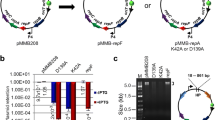Summary
A 37.5 kb region encompassing a set of the naphthalene degrading genes on the Pseudomonas plasmid NAH7 was found to be transposable only in the presence of the transposase encoded by the Tn1721 subgroup of the class II transposons. This newly identified mobile element, designated Tn4655, contained short (38 bp) terminal inverted repeats which shared extensive sequence homology with those of members of the Tn1721 subgroup. Tn4655 transposed by a two-step process involving formation of the cointegrate followed by its subsequent resolution. In contrast to the defect in the trans-acting factor for the first step, a functional system for the latter step was encoded within a 2.4 kb region in Tn4655. Analysis of deletion and insertion mutants demonstrated that the 2.4 kb region contained the cis-acting (res) site and the gene for a trans-acting factor (resolvase); complementation analysis indicated that Tn4655 resolvase function was not interchangeable with those of other well-studied class 11 transposons, including the Tn1721 subgroup. Tn4655 had no DNA sequences that were hybridizable with the transposase or resolvase genes of the Tn1721 subgroup.
Similar content being viewed by others
Abbreviations
- Ap:
-
ampicillin
- Cb:
-
carbenicillin
- Cm:
-
chloramphenicol
- Km:
-
kanamycin
- Sm:
-
streptomycin
- Tc:
-
tetracycline
- Tp:
-
trimethoprim
References
Avila P, de la Cruz F (1988) Physical and genetic map of the IncW plasmid R388. Plasmid 20:155–157
Bagdasarian M, Lurz R, Rückert B, Franklin FCH, Bagdasarian MM, Frey J, Timmis KN (1981) Specific-purpose plasmid cloning vectors II. Broad host range, high copy number, RSF1010-derived vectors, and a host-vector system for gene cloning in Pseudomonas. Gene 16:237–247
Bayley SA, Morris DW, Broda P (1979) The relationship of degradative and resistance plasmids of Pseudomonas belonging to the same incompatibility group. Nature 280:338–339
Burlage RS, Hooper SW, Sayler GS (1989) The TOL (pWW0) catabolic plasmid. Appl Environ Microbiol 55:1323–1328
Cane PA, Williams PA (1986) A restriction map of naphthalene catabolic plasmid pWW60-1 and the location of some of its catabolic genes. J Gen Microbiol 132:2919–2929
Chakrabarty AM, Friello DA, Bopp LH (1978) Transposition of plasmid DNA segments specifying hydrocarbon degradation and their expression in various microorganisms. Proc Natl Acad Sci USA 75:3109–3112
de Bruijn FJ, Lupski JR (1984) The use of transposon Tn5 mutagenesis in the rapid generation of correlated physical and genetic maps of DNA segments cloned in multicopy plasmids — a review. Gene 27:131–149
Feinberg AP, Vogelstein B (1983) A technique for radiolabeling DNA restriction endonuclease fragments to high specific activity. Anal Biochem 132:6–13
Fellay R, Frey J, Krisch H (1987) Interposon mutagenesis of soil and water bacteria: a family of DNA fragments designed for in vitro insertional mutagenesis of Gram-negative bacteria. Gene 52:147–154
Frantz B, Chakrabarty AM (1986) Degradative plasmids in Pseudomonas. In: Sokatch JR (ed) The bacteria, vol X. The biology of Pseudomonas. Academic Press, London, pp 295–323
Harayama S, Leppik RA, Rekik M, Mermod N, Lehrbach PR, Reineke W, Timmis KN (1986) Gene order of the TOL catabolic plasmid upper pathway operon and oxidation of both toluene and benzyl alcohol by the xylA product. J Bacteriol 167:455–461
Harayama S, Rekik M, Wasserfallen A, Bairoch A (1987) Evolutionary relationships between catabolic pathways for aromatics: conservation of gene order and nucleotide sequences of catechol oxidation genes of pWW0 and NAH7 plasmids. Mol Gen Genet 210:241–247
Lederberg EM (1987) Plasmid Reference Center Registry of transposon (Tn) and insertion sequence (IS) allocations through December 1986. Gene 51:115–118
Lehrbach PR, McGregor I, Ward JM, Broda P (1983) Molecular relationships between Pseudomonas IncP-9 degradative plasmids TOL, NAH, and SAL. Plasmid 10:164–174
Maniatis T, Fritsch EF, Sambrook J (1982) Molecular cloning: a laboratory manual. Cold Spring Harbor Laboratory, Cold Spring Harbor, New York
Miller JH (1972) Experiments in molecular genetics. Cold Spring Harbor Laboratory, Cold Spring Harbor, New York
Sanger F, Nicklen S, Coulson AR (1977) DNA sequencing with chain-terminating inhibitors. Proc Natl Acad Sci USA 74:5463–5467
Schell MA, Sukordhaman M (1989) Evidence that the transcription activator encoded by the Pseudomonas putida nahR gene is evolutionarily related to the transcription activators encoded by the Rhizobium nodD genes.J Bacteriol 171:1952–1959
Shaw LE, Williams PA (1988) Physical and functional mapping of two cointegrate plasmids derived from RP4 and TOL plasmid pDK1. J Gen Microbiol 134:2463–2474
Sherratt D (1989) Tn3 and related transposable elements: site-specific recombination and transposition. In: Berg DE, Howe MM (eds) Mobile DNA. American Society for Microbiology, Washington DC, pp 163–184
Simon R, Priefer U, Pühler A (1983) A broad host range mobilization system for in vivo genetic engineering: transposon mutagenesis in gram-negative bacteria. Bio/technology 1:784–791
Southern EM (1975) Detection of specific sequences among DNA fragments separated by gel electrophoresis. J Mol Biol 98: 503–517
Tsuda M, Iino, T (1987) Genetic analysis of a transposon carrying toluene degrading genes on a TOL plasmid pWW0. Mol Gen Genet 210:270–276
Tsuda M, Iino T (1988) Identification and characterization of Tn4653, a transposon covering the toluene transposon Tn4651 on TOL plasmid pWW0. Mol Gen Genet 213:72–77
Tsuda M, Minegishi K-I, Iino T (1989) Toluene transposons Tn4651 and Tn4653 are class II transposons. J Bacteriol 171:1386–1393
Watson N (1988) A new revision of the sequence of plasmid pBR322. Gene 70:399–403
Yanisch-Perron C, Vieira J, Messing J (1985) Improved M13 phage cloning vectors and host strains: nucleotide sequences of the M13mpl8 and pUC19 vectors. Gene 33:103–119
Yen K-M, Gunsalus IC (1982) Plasmid gene organization: naphthalene/salicylate oxidation. Proc Natl Acad Sci USA 79:874–878
Yen K-M, Sullivan M, Gunsalus IC (1983) Electron microscope heteroduplex mapping of naphthalene oxidation genes on the NAH7 and SAL1 plasmids. Plasmid 9:105–111
Author information
Authors and Affiliations
Additional information
Communicated by M. Sekiguchi
Rights and permissions
About this article
Cite this article
Tsuda, M., Iino, T. Naphthalene degrading genes on plasmid NAH7 are on a defective transposon. Mol Gen Genet 223, 33–39 (1990). https://doi.org/10.1007/BF00315794
Received:
Issue Date:
DOI: https://doi.org/10.1007/BF00315794



